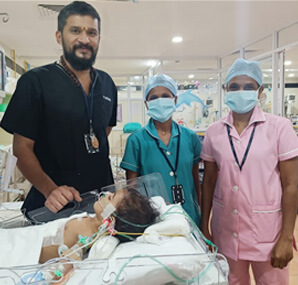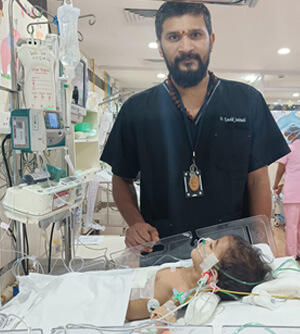The Healers’ Journal: Knocking out children for their good
June 16, 2022 | Contributed by Dr Kaushik Jothinath
It’s a common issue that people don’t understand the role of anaesthesiologists, and it’s often assumed that we take care of pain by giving miracle injections. But our role is a lot more diverse, as we take care of everything that happens during the surgery, except the surgery itself. We are responsible for controlling your pain, breathing, blood pressure and heart rate amongst other things, which include the temperature and air conditioning. In other words, we set up the mood and milieu within the operation theatre and ensure the general health and happiness of the patient and the operation theatre populace.
Evolving into a Pediatric Cardiac Anaesthesiologist

Since paediatric cardiology itself is an evolving field, pediatric cardiac anesthesia is in a nascent stage too. From being an anesthesiologist with ten hands, as I transitioned into heart disorder treatment, I ended up having a couple more hands. Now I double up as a perioperative echocardiographer and as an intensive care physician (in centres which do not have a dedicated intensive care back up).
This evolution takes place over many phases as you first learn to grapple with your own fears of inadequacy to handle miniature human beings who need Congenital Heart Defect treatment. Once we overcome these fears, we slowly start looking at and understanding what happens with each type of heart disorder treatment. The quintessential “hole in the heart” turns out to be one big one in our hearts as the realization dawns on us that some of these little hearts have their entire circuitry wrong. Here is a my humble attempt of putting the whole experience of knocking out children for their own good into various stages:
- Getting the ship ready: Once we understand what the child’s condition is, we devise a plan to safely anesthetize these little ones. It is then that you understand that each child is different and that each one comes with their own set of problems. Thus, a separate plan has to be drawn up for each one, often times in the operation theatre itself.
- Letting the ship sail: As a first step, we give medicines to put the child to sleep and take over his breathing with the help of a ventilator. This step is crucial, as the pace of breathing, if it’s too fast or too slow, can have adverse effects. Once the ship has started to sail, our role as a perioperative echocardiographer takes precedence, as we detail the anatomical abnormalities to the surgeon. We help them get a real-time vision of the abnormality and help them plan the repair once they “arrest the heart”.
- Docking the ship: Normally the beating heart is filled with blood, which makes it impossible to conduct a repair. Thus, the ship must be docked before we get the repairs done. This miracle of stopping the heart and bringing it back to life is done by the cardiac perfusionist with the help of the cardiopulmonary bypass machine. Thus, the perfusionist takes over the role of the heart during surgery and ensures that the heart is empty for the surgeon to carry out the surgical repair. At the same time, he maintains blood flow to all the vital organs in the body using the cardiopulmonary bypass machine.
- Setting the ship sail again: Once the surgeon conducts the repair, we slowly make the heart beat again and resume its function of supplying blood to the entire body. Again, this time is extremely crucial too, as we have to determine what is the optimum heart rate and blood pressure to maintain blood flow to the entire body. For each child, depending on the age and the type of Congenital Heart defect treatment, this combination of heart rate and blood pressure is different. As anesthesiologists, we have to determine the correct combination in conjunction with the surgeon and start medications to ensure the same. Once we ensure that the ship has started sailing, we determine whether the surgery conducted has had the desired result or not. This is done using echocardiography, as we determine whether the defect has been corrected completely or there are any residual issues which require surgical attention. Once it is decided that the surgical repair is optimal, we complete the closure of the chest and shift the child to the ICU.
- Anchoring the ship: Once the child reaches the ICU we connect the child to the ventilator and ensure that the medications to support the blood pressure and heart rate are at their optimal doses. Once we are satisfied that the heart has recovered well from the surgery and will be able to perform its functions optimally, we slowly reduce the dosage of anesthetic medications. With this, the child’s dependence on the ventilator reduces as he/she starts to breathe again and we disconnect from the ventilator.
- The divine hand:

A lot of the reasons why children’s hearts are deformed are still unknown or under research. Hence, at many times, we as paediatric physicians are at the mercy of divine intervention. As a parent, I would think a hundred times before letting my kid be with someone even for a moment. I am therefore constantly reminded of this trust that the parent has in our team when they hand over their child for surgery. Thus, every time we take a child from the parent as a paediatric cardiac anesthesiologist, it is with enormous responsibility, apprehension and countless prayers for divine intervention to help in setting up the stage for a smooth surgery and recovery.
Working as a paediatric cardiac anesthesiologist, I believe my role is that of a negotiator. Trying to correct the complex deformity is the surgeon and his team. The one above decides whether the child survives or not. As a paediatric cardiac anesthesiologist, I believe my role is to conduct a smooth negotiation between these two and ensure that the little one who needs help wins at the end of the day.
Dr Kaushik Jothinath is the highly qualified and experienced paediatric cardiac anesthesiologist at our hospital partner GKNM Hospital, Coimbatore in Tamil Nadu. With clinical expertise in Transesophageal Echocardiography (TEE) and fast tracking pediatric cardiac surgeries, he has also authored books like Anethesia Review.

